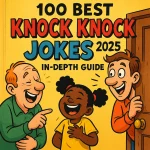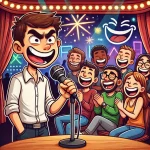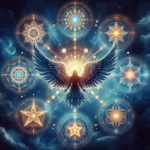- Top 100 Best Christmas Movies 2025 In-Depth Guide - 07/10/2025
- Top 100 Best Christmas Family Games 2025 - 07/10/2025
- Top 100 Best Fun Family Games 2025 In-Depth Guide - 07/08/2025

Table of Contents
The Art of Dark Humor: 2025 A Deep Dive into Controversial Comedy
Introduction: Laughing in the Face of Darkness
Dark humor, often referred to as gallows humor or black comedy, is both polarizing and captivating. By blending hilarity with taboo subjects like mortality, tragedy, and human suffering, it challenges societal norms and pushes boundaries. While not for everyone, dark humor offers a critical lens to explore uncomfortable truths that other forms of comedy might avoid. It thrives on irony, satire, and absurdity, providing levity amid chaos and raising questions about its societal role and ethical implications.
The Psychology Behind Dark Humor: Why We Laugh at the Grim
Understanding why people enjoy dark humor involves exploring its psychological roots. Researchers argue that laughter at uncomfortable themes often acts as a coping mechanism. It helps reduce stress and process difficult emotions, allowing individuals to build resilience.
Key Psychological Insights:
- Emotional Regulation: By finding humor in tragedy, people gain perspective and control over seemingly helpless situations.
- Cognitive Complexity: A 2017 study by the Medical University of Vienna found that dark humor enthusiasts often have high intelligence levels and strong emotional detachment.
| Aspect | Findings |
|---|---|
| Cognitive Ability | High intelligence levels |
| Emotional Stability | Lower aggression and higher resilience |
| Social Perception | Ability to understand complex social contexts |
| Humor Processing | Skill in recognizing irony and satire |
Dark humor is particularly prominent in high-stress professions, such as healthcare and law enforcement, where it serves as an essential coping tool. It is not uncommon for professionals in these fields to use gallows humor as a shield against the psychological toll of their work.
Beyond professional settings, dark humor also serves a broader psychological function for individuals dealing with personal struggles. By laughing at the absurdities of life’s darker moments, people can regain a sense of control and detachment.
A Historical Perspective: Dark Humor Through the Ages
Ancient Origins:
Dark humor has existed for millennia. Aristophanes’ sardonic plays in Ancient Greece and Shakespeare’s macabre wit in works like Hamlet reflect early examples of humor addressing mortality and societal flaws. These works often used satire to critique political systems and societal hypocrisies, demonstrating how humor has long been intertwined with cultural commentary.
Enlightenment Satire:
Jonathan Swift’s A Modest Proposal stands as a hallmark of biting satire, using dark humor to critique societal injustice. The grotesque proposal to solve famine by eating children highlighted the absurdity of societal indifference to suffering, making it one of the most powerful examples of dark humor used as a tool for advocacy.
Modern Adaptations:
The 20th century saw an explosion of dark humor in response to global crises. Writers like Joseph Heller (Catch-22) and filmmakers like Stanley Kubrick (Dr. Strangelove) used absurdity to highlight war’s futility. The existential dread that followed the world wars and the rise of nuclear anxiety made dark humor a vital outlet for processing fear and uncertainty.
Digital Revolution:
From television shows like The Simpsons and Rick and Morty to viral internet memes, dark humor continues to adapt to evolving cultural contexts. The internet, in particular, has democratized comedy, enabling individuals to share dark humor on a global scale. However, this accessibility has also led to ethical debates about the boundaries of acceptable humor.
Popular Examples: Dark Humor Across Mediums
- Stand-up Comedy: Icons like George Carlin and Ricky Gervais blend dark humor with sharp societal critiques. They address sensitive topics such as religion, death, and inequality, often sparking debates about the limits of comedic freedom.
- Television: Shows such as South Park and Bojack Horseman explore addiction, mental health, and corruption with irreverence. These series use satire and absurdity to tackle complex social issues in ways that resonate with audiences across demographics.
- Literature: Novels like Slaughterhouse-Five by Kurt Vonnegut and American Psycho by Bret Easton Ellis use dark humor to dissect trauma, societal decay, and human nature. Through grotesque imagery and biting wit, these works provide critical insights into the human condition.
- Online Content: Social media memes tackle everything from climate change to personal anxiety with grim wit. Platforms like Twitter and Reddit have become hubs for dark humor, where anonymity allows people to push boundaries further than in traditional media.
Dark humor also extends to visual arts, video games, and podcasts, reflecting its versatility as a medium for creative expression.
Ethics and Controversy: The Debate Over Dark Humor
Dark humor often walks a tightrope between catharsis and offense. While some argue it fosters critical thinking and challenges societal taboos, critics worry it perpetuates harmful stereotypes.
Ethical Dilemmas:
| Pros | Cons |
|---|---|
| Encourages critical thinking | May offend or alienate audiences |
| Acts as a coping mechanism | Can perpetuate harmful stereotypes |
| Challenges societal taboos | Risks trivializing serious issues |
| Provides perspective on adversity | Could be misinterpreted or misused |
The concept of “punching up” versus “punching down” is central to these debates. Humor targeting oppressive systems is often praised, while jokes at the expense of vulnerable groups are widely criticized. For example, satirical commentary on corrupt politicians is generally celebrated, whereas mocking individuals struggling with disabilities often crosses ethical boundaries.
Creators of dark humor must be mindful of their intent and the potential impact of their content. Context, audience, and delivery all play crucial roles in determining whether a joke lands or offends.
Crafting and Consuming Dark Humor: A Guide
- Know Your Audience: Understand the sensitivities of your audience to tailor your approach. An inappropriate joke in the wrong setting can lead to misunderstandings or backlash.
- Avoid Punching Down: Focus humor on power structures rather than marginalized groups. This ensures the humor remains thought-provoking rather than harmful.
- Ensure Context Adds Value: Make sure the joke contributes insight rather than shock for shock’s sake. Context matters in framing dark humor effectively.
- Stay Open to Feedback: Accept constructive criticism and adjust when necessary. Recognizing when a joke fails to connect is vital for creators to refine their craft.
Cultural Contexts: Global Perceptions of Dark Humor
Dark humor’s reception varies by culture:
- Western Cultures: Known for liberal use of satire, often embracing dark humor in media. Shows like Family Guy and comedians like Bill Burr thrive in these environments.
- Eastern Cultures: Subtler approaches often include philosophical undertones. For instance, Japanese dark humor often blends existential themes with cultural traditions.
- The Internet: As a global platform, online spaces amplify both the creativity and ethical dilemmas of dark humor. Memes about shared global challenges, like the COVID-19 pandemic, highlight how humor can unite diverse cultures.
Reference Links
- Medical University of Vienna Study on Dark Humor
- Historical Evolution of Humor
- Ethics of Comedy
- Satire and Social Commentary

Conclusion: A Balancing Act
Dark humor occupies a unique and controversial space in the comedic landscape. Its ability to tackle difficult subjects with wit and irony makes it a powerful tool for reflection and resilience. However, its effectiveness hinges on context, intention, and audience perception. By fostering dialogue and understanding, dark humor can remain a profound art form that challenges conventions while navigating the complexities of human existence.
As society continues to evolve, so too will the boundaries of dark humor. By striking the right balance between insight and sensitivity, this polarizing yet impactful genre will continue to provoke thought, inspire resilience, and spark conversations about life’s most challenging aspects.
🔥 Amazon’s Top Picks for Dad Joke Lovers – Limited-Time Deals! 🔥
Love Dad Jokes? 😂 Take your humor to the next level with these Amazon bestsellers – perfect for dads, joke enthusiasts, and family fun!
🎁 🚀 Hurry! Limited-Time Discounts Available! ⏳
✅ Exceptionally Bad Dad Jokes 📖 – So Awful, Yet So Funny!
✔ Packed with cringe-worthy, groan-inducing dad jokes that never get old!
✅ Funny Dad Mug ☕ – The Perfect Gag Gift!
✔ “Thank You for Teaching” design – the ultimate coffee cup for pun-loving dads!
✅ Pun Intended Party Game 🎲 – Hilarious Game for Pun Lovers!
✔ A must-have for game nights, family gatherings & pun enthusiasts!
👉 Shop Now on Amazon & Grab These Deals Before They’re Gone! 🚀
Recommended Articles:
What Can I Feed a Stray Cat: 2025 Comprehensive Guide – love a happy home
What to Do if You Find a Stray Dog 2025 – love a happy home
- Top 100 Best Christmas Movies 2025 In-Depth Guide
- Top 100 Best Christmas Family Games 2025
- Top 100 Best Fun Family Games 2025 In-Depth Guide
- Top 100 Best Family Games 2025 Ultimate Guide
- 100 Talk Show Hosts 2025 In-Depth Guide
- 100 Best Funny Dad Jokes 2025 In-Depth Guide
- 100 Best Funny Games 2025 In-Depth Guide
- 100 Best Funny Names 2025 In-Depth Guide
- 100 Best Good Jokes 2025 In-Depth Guide
- 100 Best Christmas Jokes 2025 🎅 In-Depth Guide
- 100 Best Corny Jokes 2025 In-Depth Guide
- 100 Best Kids Jokes 2025 In-Depth Guide
- 100 Best Knock Knock Jokes 2025 In-Depth Guide
- 100 Best Dark Jokes 2025 😈 | In-Depth & Hilarious Guide
- 100 Best Dark Humor Jokes 2025 In-Depth Guide
- 100 Attractions in the World 2025 In-Depth Guide
- Amazon Best Sellers in Clothing Shoes: Top 10 2025
- Walmart Photo Center: The Ultimate Guide 2025
- Capybara as a Pet: The Ultimate Guide 2025
- Top 100 Attractions in the World 2025
- US Female Movie Stars Top 10 2025 In-Depth Guide
- Who is the Most Handsome Man in the World?
- Top 100 Party Entertainment Ideas 2025
- 100 Best Dad Jokes That Never Get Old 2025
- US Male Movie Stars Top 10
- How to Make Slime 2025 In-Depth Guide
- YouTube History Top 10 Funny Videos 2025 In-Depth
- How to Make a Paper Airplane 2025 In-Depth Guide
- Can Dogs Eat Fruit? A Comprehensive Guide 2025
- The Funniest Dad Jokes 2025 In-Depth Guide
- Guess What Jokes: 2025 A Playful Exploration
- 100 Funny Jokes 2025 In-Depth Guide
- Knock Knock Jokes: 2025 A Playful Dive into Humor
- 2025 100 Best Dad Jokes In-Depth Guide
- Best Dry Humor 2025 In-Depth Guide
- Funny Responses to “How Are You”: Clever Comebacks
- Dark Humor Memes: 2025 A Deep Dive
- Dark Humor Memes: 2025 A Deep Analysis
- Dark Humor: 2025 A Deep Dive
- What the Difference Between Jokes 2025?
- Funny Jokes: 2025 A Deep Dive into Humor
- Funny Dad Jokes: 2025 A Deep Dive into Humor
- How to Be Funny: 2025 A Comprehensive Guide
- Funny Dad Jokes: 2025 A Timeless Source of Laughter
- Funny Names 2025: Unusual Monikers
- Funny Names: 2025 A Journey Through Humor
- Funny Jokes 2025: Universal Joy
- Funny Jokes: 2025 Exploring Humor
- Calico Cat Names: 2025 Ultimate Guide
- Why Are Dogs So Cute? In-Depth Guide 2025
- Can Dogs Eat Tomatoes? A Complete Guide for Pet Owners
- What Can Dogs Eat? 2025 A Complete Guide
- Why Are Cats So Cute 2025
- Can Dogs Eat Cat Food 2025 In-Depth Guide
- Why Does My Cat Lick Me 2025
- 999 Angel Number Meaning: A Complete Guide
- 888 Angel Number Meaning: A Powerful Symbol
- 666 Angel Number Meaning: Hidden Meaning
- Meaning of 555 in Love: Spiritual and Symbolic Messages
- 333 Angel Number Meaning: A Spiritual Guide
- 222 Angel Number Meaning: A Comprehensive Guide
- 777 Angel Number Meaning: A Comprehensive Guide
- 444 Angel Number Meaning: A Comprehensive Guide
- 111 Angel Number Meaning: A Comprehensive Guide
- Best Ginger Cat Names(25 Types Perfect Choice)
- What is the Krabby Patty Secret Formula? 2025 Deep Dive
- Best SpongeBob Party(1 Complete Guide)
- The Lovable Villain of SpongeBob: Plankton
- SpongeBob SquarePants(Character Design and Voice Actor)
- SpongeBob SquarePants: Iconic Character Introductions
- Classic SpongeBob SquarePants Episodes and Quotes
- SpongeBob SquarePants: All Character Introductions
- SpongeBob SquarePants: The Eternal Optimist
- SpongeBob Meme: The Phenomenon Explained
- Toy Poodle: The Perfect Petite Companion












































































